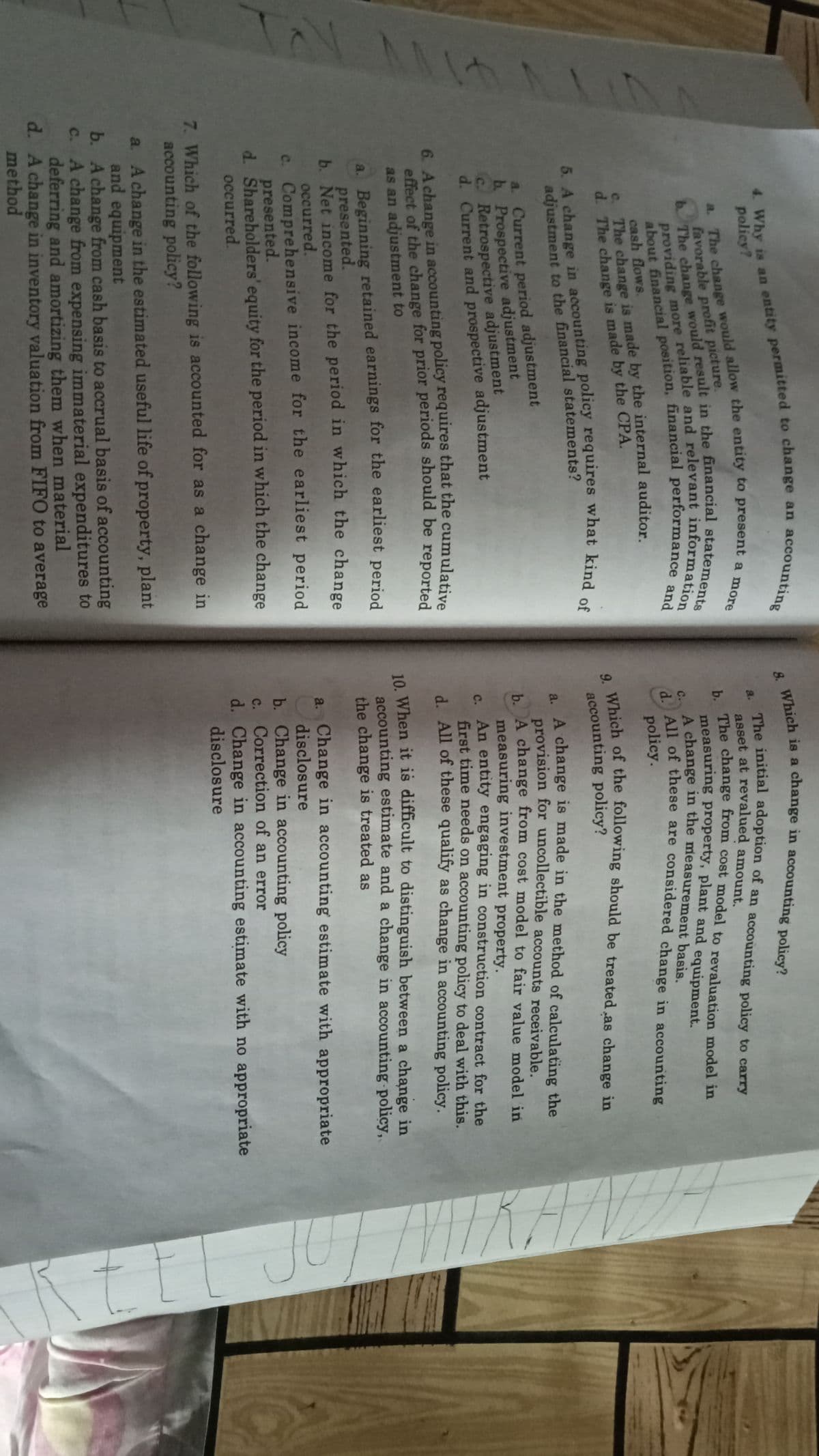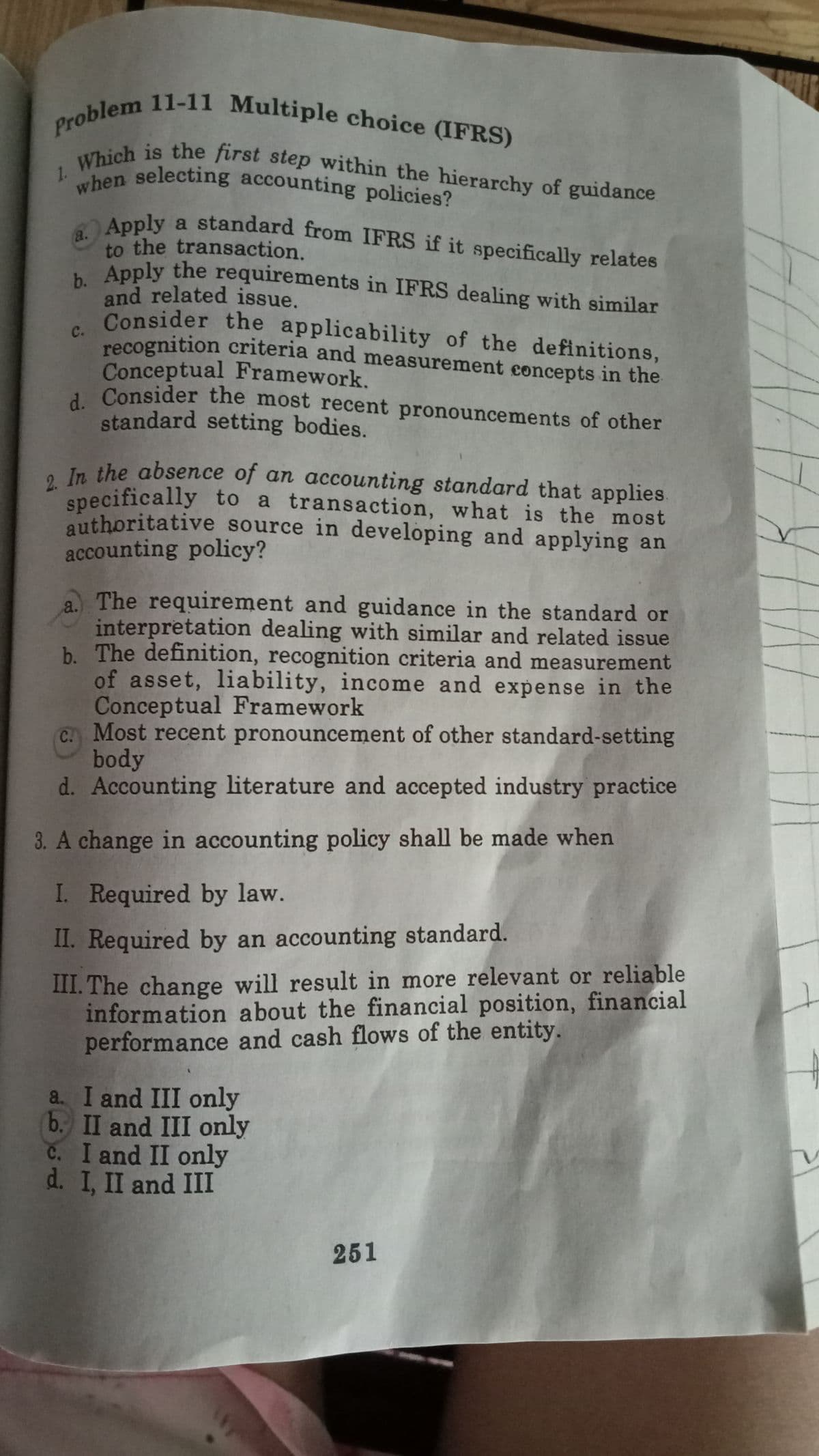4. Why is an entity permitted to change an account policy? a. The change would allow the entity to present a more favorable profit picture. bThe change would result in the financial statements providing more reliable and relevant information about financial position, financial performance and cash flows. e. The change is made by the internal auditor d. The change is made by the CPA.
4. Why is an entity permitted to change an account policy? a. The change would allow the entity to present a more favorable profit picture. bThe change would result in the financial statements providing more reliable and relevant information about financial position, financial performance and cash flows. e. The change is made by the internal auditor d. The change is made by the CPA.
Chapter1: Accounting As A Tool For Managers
Section: Chapter Questions
Problem 10MC: Which of the following statements is incorrect? The practice of management accounting is fairly...
Related questions
Question

Transcribed Image Text:4. Why is an entity permitted to change an account:
policy?
The initial adoption of an accoùnting policy to carry
a.
The change from cost model to revaluation model in
measuring property, plant and equipment.
A change in the measurement basis.
C All of these are considered change in accounting
favorable profit picture.
с.
cash flows.
The change is made by the internal auditor
policy.
accounting policy?
. A change is made in the method of calculating the
provision for uncollectible accounts receivable.
A change from cost model to fair value model in
measuring investment property.
s An entity engaging in construction contract for the
first time needs on accounting policy to deal with this.
d. All of these qualify as change in accounting policy.
adjustment to the financial statements?
a. Current period adjustment
b. Prospective adjustment
C. Retrospective adjustment
d. Current and prospective adjustment
6. Achange in accounting policy requires that the cumulative
effect of the change for prior periods should be reported
as an adjustment to
10. When it is difficult to distinguish between a change in
accounting estimate and a change in accounting policy,
the change is treated as
a. Beginning retained earnings for the earliest period
presented.
b. Net income for the period in which the change
occurred.
c. Comprehensive income for the earliest period
presented.
d. Shareholders' equity for the period in which the change
occurred.
a. Change in accounting estimate with appropriate
disclosure
b. Change in accounting policy
c. Correction of an error
d. Change in accounting estimate with no appropriate
disclosure
7. Which of the following is accounted for as a change in
accounting policy?
a. A change in the estimated useful life of property, plant
and equipment
b. A change from cash basis to accrual basis of accounting
c. A change from expensing immaterial expenditures to
deferring and amortizing them when material
d. A change in inventory valuation from FIFO to average
method
a. The change allow the entity to a more
about and
5. A in policy what kind of
b The would in the statements
providing more and information

Transcribed Image Text:2. In the absence of an accounting standard that applies.
Which is the first step within the hierarchy of guidance
Problem 11-11 Multiple choice (IFRS)
when selecting accounting policies?
b. Apply the requirements in IFRS dealing with similar
Apply a standard from IFRS if it specifically relates
1.
"hen selecting accounting policies?
a.
Apply a standard from IFRS if it specifically relates
to the transaction.
Apply the requirements in IFRS dealing with similar
and related issue.
Consider the applicability of the definitions,
c.
recognition criteria and measurement concepts in the
Conceptual Framework.
1 Consider the most recent pronouncements of other
standard setting bodies.
e In the absence of an accounting standard that applies.
specifically to a transaction, what is the most
authoritative source in developing and applying an
accounting policy?
a The requirement and guidance in the standard or
interpretation dealing with similar and related issue
b. The definition, recognition criteria and measurement
of asset, liability, income and expense in the
Conceptual Framework
C. Most recent pronouncement of other standard-setting
body
d. Accounting literature and accepted industry practice
3. A change in accounting policy shall be made when
I. Required by law.
II. Required by an accounting standard.
III. The change will result in more relevant or reliable
information about the financial position, financial
performance and cash flows of the entity.
a I and III only
b. II and III only
C. I and II only
d. I, II and III
251
Expert Solution
This question has been solved!
Explore an expertly crafted, step-by-step solution for a thorough understanding of key concepts.
This is a popular solution!
Trending now
This is a popular solution!
Step by step
Solved in 2 steps

Knowledge Booster
Learn more about
Need a deep-dive on the concept behind this application? Look no further. Learn more about this topic, accounting and related others by exploring similar questions and additional content below.Recommended textbooks for you

Principles of Accounting Volume 2
Accounting
ISBN:
9781947172609
Author:
OpenStax
Publisher:
OpenStax College

Auditing: A Risk Based-Approach to Conducting a Q…
Accounting
ISBN:
9781305080577
Author:
Karla M Johnstone, Audrey A. Gramling, Larry E. Rittenberg
Publisher:
South-Western College Pub


Principles of Accounting Volume 2
Accounting
ISBN:
9781947172609
Author:
OpenStax
Publisher:
OpenStax College

Auditing: A Risk Based-Approach to Conducting a Q…
Accounting
ISBN:
9781305080577
Author:
Karla M Johnstone, Audrey A. Gramling, Larry E. Rittenberg
Publisher:
South-Western College Pub


Auditing: A Risk Based-Approach (MindTap Course L…
Accounting
ISBN:
9781337619455
Author:
Karla M Johnstone, Audrey A. Gramling, Larry E. Rittenberg
Publisher:
Cengage Learning

Intermediate Accounting: Reporting And Analysis
Accounting
ISBN:
9781337788281
Author:
James M. Wahlen, Jefferson P. Jones, Donald Pagach
Publisher:
Cengage Learning